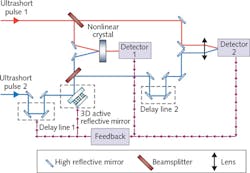Two ultrafast beams with 29.8 fs pulses are coherently combined

Coherent combination of beams from separate lasers is an important and ongoing topic, as it can potentially achieve higher beam powers than any other technical approach. What may be surprising to some is that coherent combination of ultrafast laser beams is being pursued as well. Particularly interesting is a parallel configuration for ultrafast beam combining. In this case, an example system consists of an ultrafast oscillator whose beam is split into multiple beams, with each beam then sent through an ultrafast amplifier. The hard part comes last, when multiple ultrafast pulses must be precisely aligned in relative phase so that they can be combined into one very high energy pulse.
Researchers at the China Academy of Engineering Physics and the Science and Technology on Plasma Physics Laboratory (both in Mianyang), Shanghai Jiao Tong University (Shanghai), and Xi'an Jiaotong University (Xi'an) have developed and experimentally demonstrated a method for coherently combining ultrafast laser pulses. The method, which in its prototype form combines two pulses, relies on controlling phase (relative synchronization error), piston, and tilt of the two pulses at two locations: first, at a point where the two pulses are overlaid noncollinearly (at an angle with respect to each other) and second in the far field. In the first region, a noncollinear cross-correlation allows the temporal characteristics of the pulses to be mapped to a spatial distribution of the cross-correlation signal, making the synchronization error clear. The researchers built a two-beam setup in which pulses seeded by a mode-locked oscillator were amplified to a 1 mJ pulse energy with a 29.8 fs duration and a 1 kHz repetition rate. The two beams were combined coherently with an efficiency of 99%. Reference: J. Mu et al., Opt. Lett. (Dec. 3, 2015); http://dx.doi.org/10.1364/ol.41.000234.
About the Author
John Wallace
Senior Technical Editor (1998-2022)
John Wallace was with Laser Focus World for nearly 25 years, retiring in late June 2022. He obtained a bachelor's degree in mechanical engineering and physics at Rutgers University and a master's in optical engineering at the University of Rochester. Before becoming an editor, John worked as an engineer at RCA, Exxon, Eastman Kodak, and GCA Corporation.
